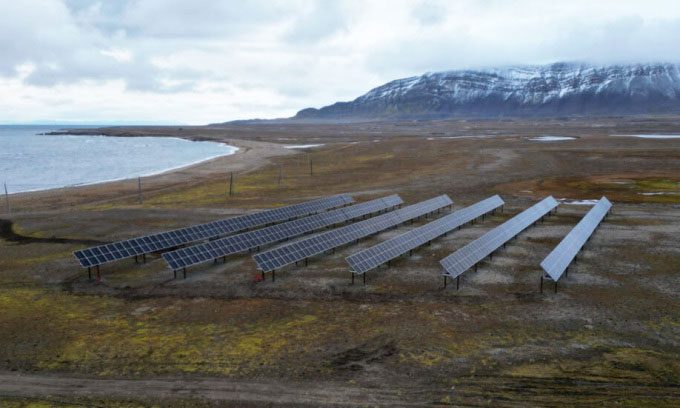Norway installs 360 solar panels, arranged in 6 rows, on a meadow in the Svalbard archipelago in the Arctic for a pilot project.
The Svalbard Archipelago is located about 1,300 kilometers from the North Pole and can only be accessed by boat or helicopter, weather permitting. The new solar panel system will begin supplying electricity to an old radio station here on September 21. Named Isjord Radio, the station has now been converted into a tourist lodge. This pilot solar project could assist remote Arctic communities in transitioning to green energy.

The solar panel system supplies electricity to the old radio station. (Photo: Viken Kantarci/AFP)
“We believe this is the northernmost ground-mounted photovoltaic system in the world. This is the first time this has been done on such a scale in the Arctic,” said Mons Ole Sellevold, a renewable energy technical advisor at Store Norske energy group.
Another 100 solar panels are installed on the roof of the radio station, expected to meet about half of the station’s electricity needs, helping to reduce CO2 emissions. Previously, the station operated on a diesel generator.
In summer, the area is bathed in sunlight, experiencing the phenomenon of “midnight sun” (where the sun does not fully set). The solar panels also benefit from the albedo effect – the reflection from snow and ice – and the low temperatures enhance their efficiency.
Conversely, during winter, the region is shrouded in darkness from early October to mid-February, making it impossible for Isjord Radio to completely eliminate fossil fuels. Therefore, Store Norske is also considering other alternatives, such as wind farms, to ensure the station continues to transition towards greener solutions.
Sellevold noted that the project emerged after considering environmental and economic factors. The purchase and transportation of diesel is very expensive, while solar panels are easy to maintain and difficult to damage. This is also a pilot project to assess the feasibility of implementing this technology for around 1,500 other locations in the Arctic that are not connected to the traditional power grid and need to transition to green energy.
According to a study published in 2022, the Arctic region has warmed nearly four times faster than the rest of the Earth over the past 40 years, causing ice to melt rapidly and ecosystems to suffer. This affects both local residents and people living elsewhere in the world, contributing to rising sea levels and extreme weather events.





















































